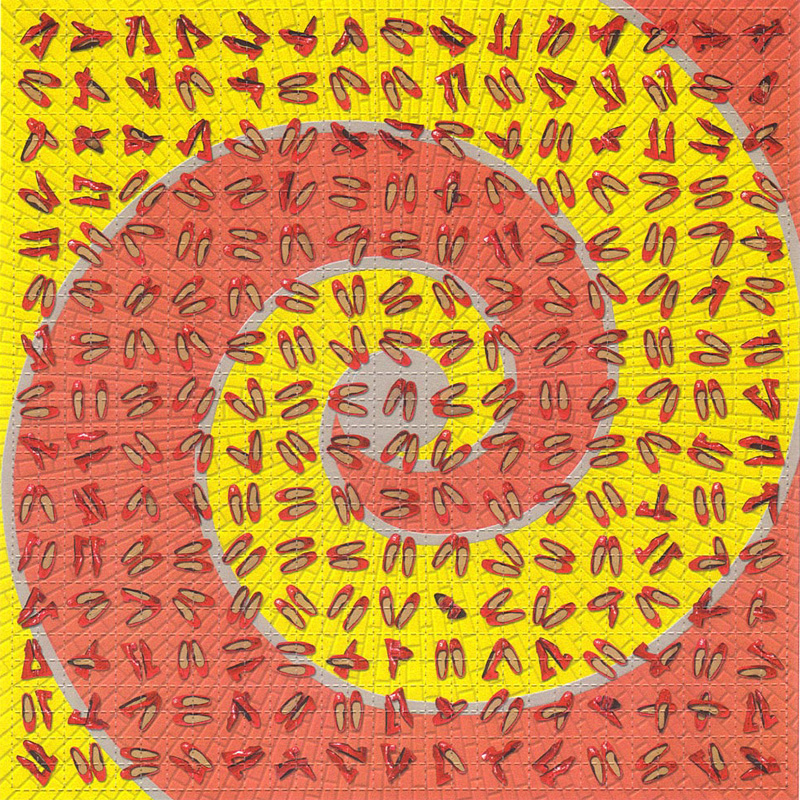|
4-Fluoro-DMT
4-Fluoro-DMT (or 4-F-DMT), also known as 4-fluoro-''N'',''N''-dimethyltryptamine, is a serotonin receptor agonist of the tryptamine family and a close analogue of psilocin (4-HO-DMT) and dimethyltryptamine (DMT). It is a modestly selective serotonin 5-HT2C receptor full agonist and doesn't appear to produce psychedelic-like effects in animals but instead produces antiobsessional-like effects. Pharmacology The drug's affinity (Ki) for the serotonin 5-HT1A receptor was 135nM. This can be compared to psilocin's affinity of 378nM and serotonin's affinity of 1.7nM. In another study, 4-F-DMT showed affinities (Ki) of 335nM for the serotonin 5-HT2A receptor, 8.39nM for the serotonin 5-HT2B receptor, and 82–84nM for the serotonin 5-HT2C receptor. Its activational potencies () and efficacies () were 949nM (49%) at the serotonin 5-HT2A receptor, 1,180nM (38%) at the serotonin 5-HT2B receptor, and 99nM (93%) at the serotonin 5-HT2C receptor. 4-F-DMT showed dramatically less pote ... [...More Info...] [...Related Items...] OR: [Wikipedia] [Google] [Baidu] |
Psilocin
Psilocin, also known as 4-hydroxy-''N'',''N''-dimethyltryptamine (4-HO-DMT), is a substituted tryptamine alkaloid and a serotonergic psychedelic. It is present in most psychedelic mushrooms together with its phosphorylated counterpart psilocybin. Psilocybin, as well as synthetic esters such as 4-AcO-DMT (psilacetin; ''O''-acetylpsilocin) and 4-PrO-DMT (''O''-propionylpsilocin), are prodrugs of psilocin. Acting on the serotonin 5-HT2A receptors, psilocin's psychedelic effects are directly correlated with the drug's occupancy at these receptor sites. It also interacts with other serotonin receptors and targets. The subjective mind-altering effects of psilocin are highly variable in their qualitative nature but resemble those of lysergic acid diethylamide (LSD) and ''N'',''N''-dimethyltryptamine (DMT). Psilocin is a Schedule I drug under the Convention on Psychotropic Substances. Uses Psilocin is used recreationally, spirituality or shamanically, and medically. ... [...More Info...] [...Related Items...] OR: [Wikipedia] [Google] [Baidu] |
Serotonin
Serotonin (), also known as 5-hydroxytryptamine (5-HT), is a monoamine neurotransmitter with a wide range of functions in both the central nervous system (CNS) and also peripheral tissues. It is involved in mood, cognition, reward, learning, memory, and physiological processes such as vomiting and vasoconstriction. In the CNS, serotonin regulates mood, appetite, and sleep. Most of the body's serotonin—about 90%—is synthesized in the gastrointestinal tract by enterochromaffin cells, where it regulates intestinal movements. It is also produced in smaller amounts in the brainstem's raphe nuclei, the skin's Merkel cells, pulmonary neuroendocrine cells, and taste receptor cells of the tongue. Once secreted, serotonin is taken up by platelets in the blood, which release it during clotting to promote vasoconstriction and platelet aggregation. Around 8% of the body's serotonin is stored in platelets, and 1–2% is found in the CNS. Serotonin acts as both a vasoconstrictor and vas ... [...More Info...] [...Related Items...] OR: [Wikipedia] [Google] [Baidu] |
Receptor Activation
In biochemistry and pharmacology, receptors are chemical structures, composed of protein, that receive and transduce signals that may be integrated into biological systems. These signals are typically chemical messengers which bind to a receptor and produce physiological responses, such as a change in the electrical activity of a cell. For example, GABA, an inhibitory neurotransmitter, inhibits electrical activity of neurons by binding to GABA receptors. There are three main ways the action of the receptor can be classified: relay of signal, amplification, or integration. Relaying sends the signal onward, amplification increases the effect of a single ligand, and integration allows the signal to be incorporated into another biochemical pathway. Receptor proteins can be classified by their location. Cell surface receptors, also known as transmembrane receptors, include ligand-gated ion channels, G protein-coupled receptors, and enzyme-linked hormone receptors. Intracellular rece ... [...More Info...] [...Related Items...] OR: [Wikipedia] [Google] [Baidu] |
Lipophilic
Lipophilicity (from Greek language, Greek λίπος "fat" and :wikt:φίλος, φίλος "friendly") is the ability of a chemical compound to dissolve in fats, oils, lipids, and non-polar solvents such as hexane or toluene. Such compounds are called lipophilic (translated as "fat-loving" or "fat-liking"). Such non-polar solvents are themselves lipophilic, and the adage "like dissolves like" generally holds true. Thus lipophilic substances tend to dissolve in other lipophilic substances, whereas hydrophilic ("water-loving") substances tend to dissolve in water and other hydrophilic substances. Lipophilicity, hydrophobicity, and non-polarity may describe the same tendency towards participation in the London dispersion force, as the terms are often used interchangeably. However, the terms "lipophilic" and "hydrophobicity, hydrophobic" are not synonymous, as can be seen with silicones and fluorocarbons, which are hydrophobic but not lipophilic. __TOC__ Surfactants Hydrocarbon-based ... [...More Info...] [...Related Items...] OR: [Wikipedia] [Google] [Baidu] |
Scratching
Scratching, sometimes referred to as scrubbing, is a DJ and Turntablism, turntablist technique of moving a vinyl record back and forth on a phonograph, turntable to produce percussive or rhythmic sounds. A crossfader on a DJ mixer may be used to fade between two records simultaneously. While scratching is most associated with Hip-hop, hip hop music, where it emerged in the mid-1970s, from the 1990s it has been used in some styles of Electronic dance music, EDM like techno, trip hop, and house music and rock music such as rap rock, rap metal, rapcore, and nu metal. In Hip-hop culture, hip hop culture, scratching is one of the measures of a DJ's skills. DJs compete in scratching competitions at the DMC World DJ Championships and IDA (International DJ Association), formerly known as International Turntablist Federation, ITF (International Turntablism, Turntablist Federation). At scratching competitions, DJs can use only scratch-oriented gear (turntables, DJ mixer, digital vinyl syste ... [...More Info...] [...Related Items...] OR: [Wikipedia] [Google] [Baidu] |
Obsessive–compulsive Disorder
Obsessive–compulsive disorder (OCD) is a mental disorder in which an individual has intrusive thoughts (an ''obsession'') and feels the need to perform certain routines (''Compulsive behavior, compulsions'') repeatedly to relieve the distress caused by the obsession, to the extent where it impairs general function. Obsessions are persistent unwanted thoughts, mental images, or urges that generate feelings of anxiety, disgust, or discomfort. Some common obsessions include fear of contamination, obsession with symmetry, the fear of acting Blasphemy, blasphemously, sexual obsessions, and the fear of possibly harming others or themselves. Compulsions are repeated actions or routines that occur in response to obsessions to achieve a relief from anxiety. Common compulsions include excessive hand washing, cleaning, counting, ordering, repeating, avoiding triggers, hoarding, neutralizing, seeking assurance, praying, and checking things. OCD can also manifest exclusively through m ... [...More Info...] [...Related Items...] OR: [Wikipedia] [Google] [Baidu] |
Animal Model
An animal model (short for animal disease model) is a living, non-human, often genetic-engineered animal used during the research and investigation of human disease, for the purpose of better understanding the disease process without the risk of harming a human. Although biological activity in an animal model does not ensure an effect in humans, many drugs, treatments and cures for human diseases are developed in part with the guidance of animal models. Animal models representing specific taxonomic groups in the research and study of developmental processes are also referred to as model organisms. There are three main types of animal models: Homologous, Isomorphic and Predictive. Homologous animals have the same causes, symptoms and treatment options as would humans who have the same disease. Isomorphic animals share the same symptoms and treatments, only. Predictive models are similar to a particular human disease in only a couple of aspects. However, these are useful in isolating ... [...More Info...] [...Related Items...] OR: [Wikipedia] [Google] [Baidu] |
Hallucinogen
Hallucinogens, also known as psychedelics, entheogens, or historically as psychotomimetics, are a large and diverse class of psychoactive drugs that can produce altered states of consciousness characterized by major alterations in thought, mood, and perception as well as other changes. Hallucinogens are often categorized as either being psychedelics, dissociatives, or deliriants, but not all hallucinogens fall into these three classes. Examples of hallucinogens include psychedelics or serotonin 5-HT2A receptor agonists like LSD, psilocybin, mescaline, and DMT; dissociatives or NMDA receptor antagonists like ketamine, PCP, DXM, and nitrous oxide; deliriants or antimuscarinics like scopolamine and diphenhydramine; cannabinoids or cannabinoid CB1 receptor agonists like THC, nabilone, and JWH-018; κ-opioid receptor agonists like salvinorin A and pentazocine; GABAA receptor agonists like muscimol and gaboxadol; and oneirogens like ibogaine and harmaline, a ... [...More Info...] [...Related Items...] OR: [Wikipedia] [Google] [Baidu] |
DOI (drug)
2,5-Dimethoxy-4-iodoamphetamine (DOI) is a psychedelic drug of the amphetamine and 4-substituted-2,5-dimethoxyamphetamine (DOx) families. It is relatively little-used as a recreational drug but is frequently used in scientific research in the study of psychedelics and serotonin receptors. DOI acts as a potent serotonin 5-HT2 receptor agonist, including of the serotonin 5-HT2A and 5-HT2C receptors. The compound has a stereocenter, and ''R''-(−)-DOI is the more active stereoisomer. 125I">sup>125I''R''-(−)-DOI is used as a radioligand and indicator of the presence of serotonin 5-HT2A receptors in studies. DOI's effects have been compared to LSD, although there are differences that experienced users can distinguish. Besides the longer duration of DOI compared to LSD, the trip tends to be more energetic than an LSD trip, with more body load and a different subjective visual experience. The after effects include residual stimulation and difficulty sleeping, which, depen ... [...More Info...] [...Related Items...] OR: [Wikipedia] [Google] [Baidu] |
Statistically Significant
In statistical hypothesis testing, a result has statistical significance when a result at least as "extreme" would be very infrequent if the null hypothesis were true. More precisely, a study's defined significance level, denoted by \alpha, is the probability of the study rejecting the null hypothesis, given that the null hypothesis is true; and the ''p''-value of a result, ''p'', is the probability of obtaining a result at least as extreme, given that the null hypothesis is true. The result is said to be ''statistically significant'', by the standards of the study, when p \le \alpha. The significance level for a study is chosen before data collection, and is typically set to 5% or much lower—depending on the field of study. In any experiment or observation that involves drawing a sample from a population, there is always the possibility that an observed effect would have occurred due to sampling error alone. But if the ''p''-value of an observed effect is less than (or equal to ... [...More Info...] [...Related Items...] OR: [Wikipedia] [Google] [Baidu] |
Drug Discrimination
Drug discrimination (DD) is a technique in behavioral neuroscience used to evaluate the discriminative stimulus properties or interoceptive cues of psychoactive drugs. In drug discrimination, a subject is trained on a training drug, and then it is tested with novel drugs to see if the novel drugs are experienced as similar to the training drug. In essence, the drug discrimination paradigm has the subject "tell" the experimenter "I think you gave me the training drug" or "I don't think you gave me anything". The discriminative stimulus properties of drugs are believed to reflect their subjective effects. When partial or full stimulus generalization of a test drug to a training drug occurs, the test drug can be assumed to have effects that are subjectively similar to those of the training drug. Drug discrimination tests are usually performed in animals, but have also been conducted in humans. Drug discrimination assays have been employed to assess whether drugs have stimulant- ... [...More Info...] [...Related Items...] OR: [Wikipedia] [Google] [Baidu] |




